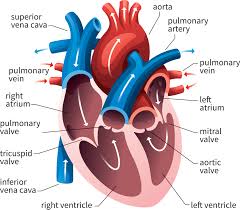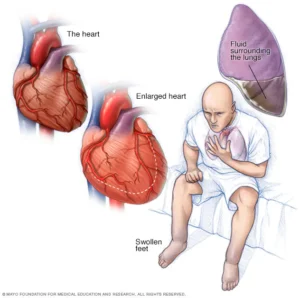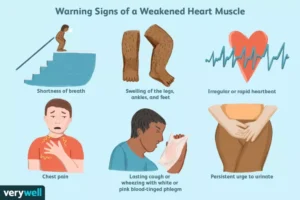How the heart is structured and functions:
The human heart is a four-chambered muscular organ that are called atriums at the top LA and RA and the bottom ones called ventricles- right ventricle=RV and left ventricle=LV. The heart is shaped and sized roughly like a man’s closed fist with two-thirds of the mass to the left of midline which is due to the left ventricle works the hardest pumping blood throughout the body so it makes that chamber the most muscular area. The right side of the heart pumps blood blood returning to the heart that went throughout the body using up most of the oxygen in it that has mainly carbon dioxide in the blood going the the right side chambers. First the right atrium and than the right ventricle to just the lungs for more oxygen to the lungs that carries mainly oxygenated blood to the left side of the heart first to the left atrium to the left ventricle that pumps that oxygenated blood through out the body to deliver to all tissues oxygen.
Think of the heart as the engine of the body. Without a engine the car would not work and without a heart the body would die. Without the lungs the heart and other tissues would not function and die. A car without a transmission would not engine would not function and the car would die.
Without oxygen our tissues would go through oxygen starvation and the body would die. A car without oil would die due to oil starvation and you need the car engine to start the car for the transmission to work with oil to be pumped.
Valves of the Heart:
Pumps need a set of valves to keep the fluid flowing in one direction and the heart is no exception. The heart has two types of valves that keep the blood flowing in the correct direction. The valves between the atria and ventricles are called atrioventricular valves (also called cuspid valves), while those at the bases of the large vessels leaving the ventricles are called semilunar valves.
The right atrioventricular valve is the tricuspid valve. The left atrioventricular valve is the bicuspid, or mitral, valve. The valve between the right ventricle and pulmonary trunk is the pulmonary semilunar valve. The valve between the left ventricle and the aorta is the aortic semilunar valve.
When the ventricles contract, atrioventricular valves close to prevent blood from flowing back into the atria. When the ventricles relax, semilunar valves close to prevent blood from flowing back into the ventricles.
What can happen to the heart if it does not function properly:
Congestive heart failure, or heart failure, is a long-term condition in which your heart can’t pump blood well enough to meet your body’s needs. Your heart is still working. But because it can’t handle the amount of blood it should, blood builds up in other parts of your body. Most of the time, it collects in your lungs, legs and feet.
Think of it like a shipping department that can’t keep up with getting all the shipments where they need to go. The shipping department is always running behind and things pile up. When things pile up, they cause issues OR think of it like plumbing if there is a problem with the water getting through the pipe lines (like our blood flow getting through the veins and arteries) you will need a plumber to fix the blockage, valve problem or broken pipe (just like the blood getting through the body due to a blockage in the vein or artery or bad heart valve or failure elsewhere in that system)
Heart Failure or Congested Heart Failure (CHF) there are types Right sided CHF or heart failure or Left sided CHF or heart failure. Sometimes the MD may even see High output failure but rare. More than 6 million people in the United States have congestive heart failure. It’s the leading cause of hospitalization in people older than 65.
Some of the complications from congestive heart failure include:
- Irregular heartbeat.
- Sudden cardiac arrest.
- Heart valve problems.
- A collection of fluid in your lungs.
- Pulmonary hypertension.
- Kidney damage.
- Liver damage.
- Malnutrition.
MOST IMPORTANTLY REMEMBER THIS:
There’s no cure for heart failure. As congestive heart failure gets worse, your heart muscle pumps less blood to your organs, and you move toward the next stage of heart failure(there are A,B,C,D stages). Since you can’t move backward through the heart failure stages, the goal of treatment is to keep you from moving forward through the stages at its slowest pace or to slow down the progression of your heart failure with giving you the chance to live as long as possible at your optimal level.
Regarding Heart Valves there is this to know:
Heart valve disease can affect anyone. But people over 65 are at higher risk. In fact, 2.5 million people over the age of 75 have aortic stenosis, one of the most common types of heart valve disease. While its symptoms can be subtle they shouldn’t be brushed off as “getting older.” Left untreated, it can progress to severe aortic stenosis, also known as heart valve failure.
People over 65 y/o are at highest risk for this and that is based on the my theory like a car the older you are the higher the risk your car is going to be worn down just like the heart (the engine to the body) the older it is the higher the risk that individual will have body part problems like the heart.
Symptoms are your body’s way of sending warning signs that you may be in danger. Unfortunately, diet and exercise can’t fix a failing heart valve. Take control by asking for a referral to a Heart Valve Team or Cardiologist so you can be evaluated.


